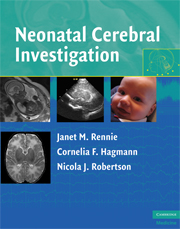Book contents
- Frontmatter
- Contents
- List of contributors
- Preface
- Acknowledgements
- Glossary and abbreviations
- Section I Physics, safety, and patient handling
- 1 Principles of ultrasound
- 2 Principles of EEG
- 3 Principles of magnetic resonance imaging and spectroscopy
- Section II Normal appearances
- Section III Solving clinical problems and interpretation of test results
- Index
- References
2 - Principles of EEG
from Section I - Physics, safety, and patient handling
Published online by Cambridge University Press: 07 December 2009
- Frontmatter
- Contents
- List of contributors
- Preface
- Acknowledgements
- Glossary and abbreviations
- Section I Physics, safety, and patient handling
- 1 Principles of ultrasound
- 2 Principles of EEG
- 3 Principles of magnetic resonance imaging and spectroscopy
- Section II Normal appearances
- Section III Solving clinical problems and interpretation of test results
- Index
- References
Summary
Introduction
Electroencephalography (EEG) monitors the function of the neonatal brain and provides a sensitive real-time measure of cerebral activity. The neonatal brain is particularly vulnerable to changes in oxygenation and blood pressure and the effects of these physiological changes can often be detected by the EEG. In addition, it is now clear that clinical seizure expression in neonates is ambiguous and most seizures can only be detected by the EEG, which can also provide helpful information regarding the differential diagnosis (Chapter 7). Electroencephalography is also the most sensitive tool available for predicting neurodevelopmental outcome in neonates with early neonatal encephalopathy, particularly that due to hypoxic ischemia, and can provide this information much earlier than any other method. Many units use continuous amplitude integrated EEG (aEEG) to monitor cerebral activity. This provides a more limited measure of cerebral activity but nonetheless can be very useful, particularly if no other monitoring is available. Continuous monitoring with EEG is becoming a standard of care in many neonatal intensive care units (NICUs) around the world.
The aim of this chapter is to describe principles of EEG and aEEG recording. At the end of this chapter the reader should feel confident enough to record either the EEG or an aEEG from a newborn baby in the NICU. They will appreciate the characteristics of different recording devices, recognize the difficulties that are particular to the NICU environment which can impede recordings, recognize common sources of artifact that often mimic events such as seizures, and appreciate the difference between EEG and aEEG. Information on the appearances of the normal neonatal EEG and aEEG can be found in Chapter 6.
- Type
- Chapter
- Information
- Neonatal Cerebral Investigation , pp. 9 - 21Publisher: Cambridge University PressPrint publication year: 2008
References
- 4
- Cited by



